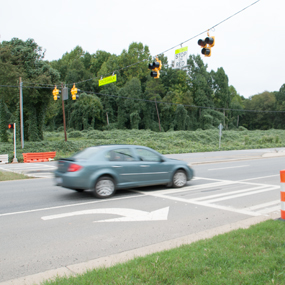Pedestrians and cyclists have a growing number of signalized crosswalks across University City’s busiest highways, even midway between major intersections.
Our third HAWK beacon – featuring numerous traffic signs, distinctive crosswalk and attention-grabbing sequences of bold, flashing orange and red lights – just began operation on North Tryon Street near the Mallard Creek bridges.
The new crossing provides a temporary detour for Mallard Creek Greenway while the state replaces highway bridges over the creek and greenway. Once the bridges are finished next year, the Mallard Creek Greenway will return to its normal path below the bridges, and the state will remove the street-level pedestrian crossing.
Two other mid-block crossings began operation in the last year – on University City Boulevard midway between Suther and John Kirk roads, and on J W Clay Boulevard near the lake at University Place.
About HAWK beacons
The HAWK beacon, short for High-Intensity Activated crosswalk, was pioneered by Tucson, Arizona, in the 1990s to provide safer pedestrian crossings on major thoroughfares where additional traffic signals for vehicles were not wanted. The idea quickly spread, helped along by research showing as much as a two-thirds drop in the number of pedestrians struck by vehicles in the new walks vs. traditional crosswalks.
North Carolina installed the first HAWK signal, also known as a pedestrian hybrid beacon, at the busy intersection of Providence and Queens Road, in Myers Park. Several more beacons now operate around Charlotte.
In University City, all the beacons provide pedestrian and bike crossings in areas with plenty of foot and bicycle traffic but no nearby road intersections.
“This is a technique that has been embraced by the engineering community,” says Scott Curry, Pedestrian Program manager for the City of Charlotte. “It’s one we have been eager to use, to get folks across the road more safely.”
Safer paths to campus and greenways
The University City Boulevard crossing serves residents of the University Walk apartments, directly across the highway from UNC Charlotte, and other nearby student housing.
Before the beacon crossing went into operation last spring, students could either walk up to a quarter mile along busy University City Boulevard to pedestrian crossings at Suther and John Kirk Roads, or dash across 6 lanes of traffic and a grass median. On a recent weekday afternoon, students queued up at the new pedestrian crossing every 2-3 minutes.
The Clay Boulevard crossing eventually will link the popular trail around University Place lake to the future Barton Creek Greenway. Work will start next spring on the new greenway, which will run from University Place to the heavily used Mallard Creek Greenway.
More traditional crossings coming soon, too
Several more traditional bike-ped crossings at highway intersections on and near campus are being added or upgraded.
A fully signalized UNC Charlotte entrance with pedestrian crossing signals is expected to begin operation in late November at Cameron Boulevard and University City Boulevard. The signalized crossing is near the growing South Campus residential area and will provide the most direct path yet for for South Campus cyclists and pedestrians headed to nearby Town Center Plaza.
As part of the LYNX light-rail project on North Tryon Street, several intersections between Institute Circle (the UNC Charlotte entrance) and Tom Hunter Road will have signalized traffic and pedestrian crossings, once roadway reconstruction is finished in 2016.
How HAWK works
(from the NC DOT)
These pedestrian hybrid beacons, or HAWK (High Intensity Activated Crosswalk) signals as they are more commonly referred to, are located over the roadway, and consists of six intervals in each sequence:
- Dark Until Activated – the signal remains dark until a pedestrian touches the push button to begin the sequence;
- Flashing Yellow – drivers should be prepared to stop;
- Solid Yellow – drivers should stop if it’s safe to do so, or proceed forward if not safe to stop;
- Solid or Steady Red – all traffic must stop; during this phase, pedestrians are shown the “Walk” signal and encouraged to cross
- Flashing Red during Pedestrian Clearance – traffic can move forward only if pedestrians have cleared the crosswalk; during this phase, pedestrians see the countdown indication and should clear the crosswalk.
- Dark Again Until Activated – traffic can proceed normally until the beacon is reactivated.




0 Comments